A relatively new material in timekeeping—employed for only the last few years—silicon continues to demonstrate its potential. It was first brought into the limelight in 2005 by Patek Philippe with its mono-crystalline silicon escape wheel (developed in partnership with various research centres, among them the Ecole Polytechnique Fédérale in Lausanne, the Institut de Microtechnique at the University of Neuchâtel, the Centre Suisse d'Electronique et de Microtechnique, and the COMLAB laboratory).
This extremely hard (1100 Vickers versus 700 Vickers for steel), corrosion-resistant, anti-magnetic, lightweight, and low-density (2.33g/cm3 versus 8g/cm3 for steel) material was initially chosen because of its tribological aspects since one of the main goals of mechanical watchmaking is to eliminate the need for lubrication. Silicon—because of its physical properties, including its perfect surface state—doesn’t need to be lubricated. This is particularly important for one of the most sensitive parts of the movement—the escapement.
New shapes
Beyond this important advantage, the particular techniques used in making silicon components (similar to processes used in selective photolithography—see DRIE sidebar) also allow the watchmaker to fundamentally rethink the shapes of these parts.

The DRIE process
The DRIE (Deep Reactive Ion Etching) process of manufacturing a silicon component part has absolutely nothing to do with traditional methods such as machining, drilling, etc., because this type of part is made entirely by ‘photographic’ means.
An image of the piece to be produced is projected onto a round silicon wafer measuring 100 mm in diameter by 0.5 mm in thickness. This sized wafer can make about 250 wheels. It is composed of three different substrates or layers of silicon, with the central substrate being the separation layer. After the ‘photo’ is developed, the exposed lacquered substrate is washed away, leaving the non-exposed parts on the wafer. The non-lacquered parts are etched with plasma down to the separation layer. The silicon wheels are then freed by isotrope etching. The pieces coming out of this operation only need to be cleaned on the surface. They are all identical and usable as they are, and do not require balancing, centring, or polishing.
The DRIE process allows the realization of unusual shapes in very tiny sizes with great precision. Tolerances are reduced by half in comparison to traditional techniques.
In 2006, Patek Philippe presented a second innovation, the Spiromax® balance spring made of Silinvar®. Obtained by a vacuum oxidation process that allows it to compensate for temperature variations, this patented silicon-based material is the result of research financed in partnership with the Swatch Group and Rolex. Its perfectly concentric nature (the symmetrical expansions and contractions of the balance spring in relation to its centre) is made possible by a terminal curve that is not turned up but rather has a noticeably thicker region at the outer end.
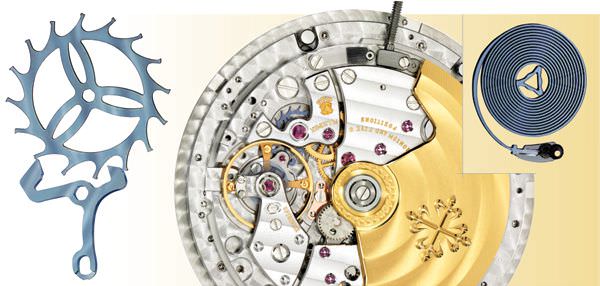
This new geometry includes an integral balance staff and stud attachment, and offers another advantage: perfect isochronous vibrations regardless of temperature variations, the presence of magnetic fields or the position of the movement. Its total thickness is three times thinner than a Breguet-type balance spring with an overcoil, thus making it easier to construct ultra-thin movements.
Patek Philippe has continued its research into the geometry of silicon-based components and this year presented another innovation—the Pulsomax® escapement. The principle of the Pulsomax® is similar to that of a traditional Swiss lever escapement except that its goal is to improve performance by optimizing functionality using a new and exclusive geometry. Created using the DRIE plasma etching process that allows for the machining of Silinvar® components on a second horizontal level, the new lever no longer needs ruby pallets. They have been replaced by the lever itself whose geometry has been redesigned (each of the two pallets has its own distinct shape). This lever works with the new Silinvar®, escape wheel, which has also been redesigned to have 16 teeth instead of the traditional 20.
The result, according to Patek Philippe’s watchmakers, is that the new lever transmits more power to the balance, thus optimizing efficiency by improving the isochronism. (Patek Philippe claims an increase in efficiency of 30 percent, which would mean that a watch with a power reserve of 48 hours would now run for 62 hours.) Other benefits include a significant and measurable improvement in performance, regulation, and reliability of the movement, as well as no longer needing lubrication, over the long term.
Ulysse Nardin, veritable pioneer

Patek Philippe is not the only brand to have worked in the realm of silicon. Ulysse Nardin was a veritable pioneer in 2000 when it launched the first prototype of its Dual Direct Escapement made of silicon. In 2002, the brand made the first balance spring and first escapement in artificial diamond, created using the same processes as Selective Ion Etching. In this case, however, the etching was not on a mono-crystalline silicon wafer but on a poly-crystalline diamond wafer.
Ulysse Nardin introduced these innovations for the first time in 2005 in a product sold under the name of Freak 28,800 V/h Diamond Heart, equipped with the Dual Ulysse escapement made of diamond. The Freak escapement was developed for Ulysse Nardin by Ludwig Oechslin. Ten years of research led up to its presentation at the Basel fair in 2001. As Oechslin explains, the Freak escapement is a “one-hour carrousel, with the movement making one rotation in one hour. Everything is epicycloidal, with the exception of the barrel which takes up the whole back side of the watch and ensures a working reserve of eight days. The movement is wound using a bezel on the back of the watch and the time is set using a bezel on the front of the watch. The objective was to make an escapement that is simpler and more reliable than a lever escapement. It succeeds thanks to a totally symmetrical escapement: the two wheels provide the same impulsion to a tiny central piece. From a theoretical point of view, it is very simple in comparison to the complex angles of the lever escapement. The construction and reliability are facilitated as well. There is also very little friction, which eliminates the need for lubrication. We used a silicon-based material to make the escapement since we needed a very tough and lightweight material in order to lower the inertia.”
This year, after a great deal of research and development, Ulysse Nardin presented an even more innovative concept, the Innovision. This timepiece involves ten innovations that nearly all involve silicon-based technologies. (See sidebar on Innovision)
Whatever the value of this extensive use of silicon, its utilization is certainly an essential factor in the Freak’s escapement, mainly for reasons of inertia and elimination of lubrication. This escapement differs fundamentally from that created by Patek Philippe whose research centred on the Swiss lever escapement. The Freak mechanism also could have theoretically been realized in traditional materials, even though the performance would have been inferior.
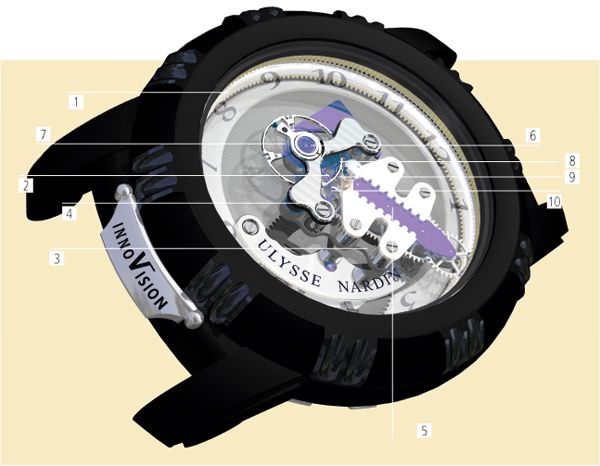
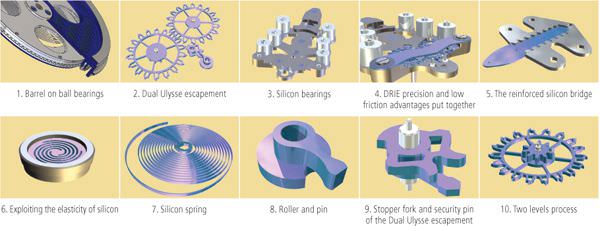
The Innovision by Ulysse Nardin
Ulysse Nardin’s Innovision is a watch prototype that combines ten technological innovations, most of which are based on DRIE and LIGA (see below) technologies, and include:
![]() silicon bearings (by replacing the rubies, there is no need for lubrication);
silicon bearings (by replacing the rubies, there is no need for lubrication);
![]() silicon escapement bridge (precision in positioning holes and low friction);
silicon escapement bridge (precision in positioning holes and low friction);
![]() silicon and nickel bridge (precision, low friction, and mechanical sturdiness);
silicon and nickel bridge (precision, low friction, and mechanical sturdiness);
![]() silicon shock absorber (due to the elasticity of silicon);
silicon shock absorber (due to the elasticity of silicon);
![]() silicon balance spring (mastery in production savoir-faire);
silicon balance spring (mastery in production savoir-faire);
![]() roller and pin are realized in one single component using the DRIE process;
roller and pin are realized in one single component using the DRIE process;
![]() stopper fork and security pin of the escapement are a single component (DRIE technology);
stopper fork and security pin of the escapement are a single component (DRIE technology);
![]() silicon escape wheel and pinion made in one single piece on two levels.
silicon escape wheel and pinion made in one single piece on two levels.
To these innovations can be added the barrel on non-lubricated ball bearings and the silicon Dual Ulysse escapement.
According to Ulysse Nardin, the goal of these applications is to essentially eliminate lubrication, take advantage of the precision of the process, demonstrate the potential of the double-sided or two-level approach, and make the most of combining DRIE and LIGA technologies.
">The Constant Escapement by Girard-Perregaux
This is not, however, the case of the Constant Escapement—the most advanced example of silicon technology yet—which was presented this year at the SIHH by Girard-Perregaux. Without the characteristic properties of silicon, notably its elasticity, this new escapement would not have seen the light of day. Its elasticity allows the silicon microstructures to remain flexible despite their hardness and has allowed watchmakers to break through boundaries of mechanical timekeeping that were considered impossible only a short time ago.
For the moment, the Constant Escapement remains a test piece but Girard-Perregaux intends to introduce it on a commercial basis within two years. Let’s take a look at how this strange creature functions.
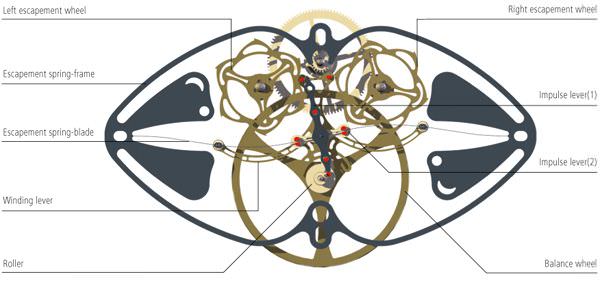

Its birth is a bit amusing and is similar to many other discoveries that occurred in large part due to ‘luck’. Nicolas Dehon, Manager of Research and Development at Girard-Perregaux, was travelling by train one day, and was casually playing with his ticket. He bended the small card back and forth between his fingers when, all of a sudden, the idea came to him of creating an escapement that no longer had a balance spring but rather a fine blade that would pass alternately from one state of tension to another, like the ticket bent in one direction and then another. To illustrate with another example of how it works, think back to your childhood and a toy that you made jump as you pressed on a curved metal strip. As the strip changed position, it acted like a spring and propelled the toy forward. The only material that could be used to take Dehon’s idea to fruition was silicon. The entire research and development departments of Girard-Perregaux and the Sowind Group (to which Girard-Perregaux belongs) were therefore mobilized for this project.

Diagram 1: Swiss lever escapement movement: diminishing amplitude over time
Diagram 2: Constant escapement movement: constant amplitude over time
Diagram 3: The amplitude variation range is four times lower for a movement with Constant escapement than for a standard movement with Swiss lever escapement
A blade finer than a human hair
The strip or blade in question is finer than a human hair. The cross-section is rectangular; its thickness is 20 micrometers; its width is one-tenth of a millimetre; and the length is approximately 20 millimetres. The blade is part of a three-piece elliptical unit made of mono-crystalline silicon (fabricated using the DRIE process) that supports it as well as the impulse lever. This single unit serves as the escapement spring.
This spring functions as a micro-accumulator of energy. “Each time the oscillator vibrates, it stores and then releases a tiny quantity of energy—less than one milli-joule. This energy is stored in the escapement spring that ‘buckles’ from a stable state to a meta-stable state, which by definition has more energy than the stable state. The transition from the first state to the second state releases energy that serves to maintain the balance’s amplitude at a constant state right up to the end of the power reserve,” explains a spokesperson for the brand.
This ‘constant’ energy is transmitted to the escapement wheels by the impulse lever that has two different arms. One carries the guard-pin (1) and the other holds two pairs of ruby pins (2), between which is located the small escapement spring blade. The impulse lever is made of pure nickel using LIGA technology (see sidebar on LIGA). The two escapement wheels have six teeth and are also made of silicon for questions of friction, but they could also be made of pure nickel or another traditional metal. As for the winding lever that charges the blade with energy, it is also made of pure nickel that has been gold-plated.

The LIGA process
LIGA (a German acronym for lithography, electroplating, and moulding) is a technique of micro-fabrication dating back to the beginning of the 1980s, which combines photolithography and electroforming. First used in medical applications, this ‘mixed’ technology is now used to create high quality micro-components with an excellent surface finish, in particular movement parts with no defects. It also allows for innovation in terms of form and function of the various components. In collaboration with the firms, Sigatec and Mimotec, Ulysse Nardin has developed various components for its Innovision watch by combining DRIE and LIGA technologies to obtain bi-material pieces in silicon and nickel.
According to studies provided by Girard-Perregaux, this new type of escapement “delivers impulsions with constant energy,” thus providing “constant amplitude and rate” despite the variations in energy that it receives. (Returning to the example of the jumping toy, pressing with more or less force on the toy’s metal strip does not change the amplitude of its jump, which is only dependent on the strip moving from one position to another.) This stability is further strengthened by the fact that, like the traditional lever escapement, the Constant Escapement provides two impulses per oscillation. (See charts.)
Girard-Perregaux’s ultimate goal is to gradually integrate this innovation into its watches, thus offering them exceptional chronometric performance. It will take approximately two years of development and testing before this escapement is finally approved for commercialization. From an aesthetic point of view, it also opens new horizons, not only in the future design of dials that can be largely left open to show the entire escapement, but also in terms of visual appearance. The perfectly plane surfaces obtained from silicon are rarely achieved in traditional watchmaking. In addition, they offer very unusual iridescent colours, changing from turquoise blue to deep purple, depending on the angle of vision. This effect is due to the oxide layer that coats the silicon.
It is quite clear that silicon is indeed one of the new frontiers of contemporary timekeeping.
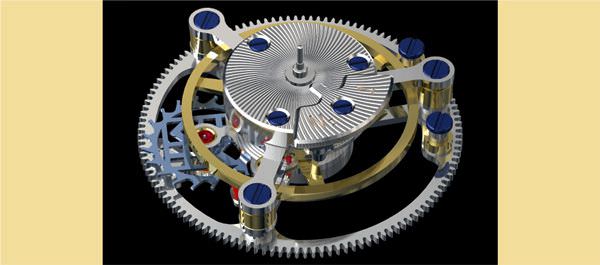
Frederique Constant’s Tourbillon Manufacture with silicon escapement wheel
Last year, Frederique Constant presented one of its Heart Beat models equipped with a silicon escape wheel. This year, the Geneva brand has presented a new tourbillon, designed in-house, that integrates the same silicon escape wheel. The principal advantage of this innovation is greater energy efficiency of the tourbillon due to the wheel’s light weight and the reduction in friction. Frederique Constant indicates that it can obtain an amplitude of more than 300 degrees between the vertical and horizontal positions. Moreover, the frequency of this tourbillon is 4 Hertz or 28,800 vibrations per hour.
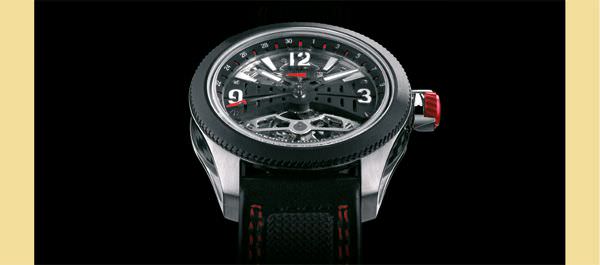
Extreme LAB, another avenue
Jaeger-LeCoultre’s Extreme LAB is the first watch that does not require any lubrication at all. It achieves this by combining different materials and surface treatments. In this watch, however, only the escape wheel is made of silicon. As for the other components, they use new geometries and a whole series of innovative materials:
![]() the rubies have been replaced by an Easium carbon-nitride treatment;
the rubies have been replaced by an Easium carbon-nitride treatment;
![]() the staffs and pivots are made of rolled steel and treated with molybdenum bisulfide;
the staffs and pivots are made of rolled steel and treated with molybdenum bisulfide;
![]() the lift of the palettes are made of black mono-crystalline diamond;
the lift of the palettes are made of black mono-crystalline diamond;
![]() the pivots of the staffs are treated with molybdenum bisulfide;
the pivots of the staffs are treated with molybdenum bisulfide;
![]() the component parts of the winding and setting mechanism are treated with nickel Teflon (or Nickel PTFE);
the component parts of the winding and setting mechanism are treated with nickel Teflon (or Nickel PTFE);
![]() the smooth motion of the oscillating weight is assured by ceramic ball bearings;
the smooth motion of the oscillating weight is assured by ceramic ball bearings;
![]() the oscillating weight has an original shape and is composed of two distinct elements: a cut-out support made of carbon fibre and a section made of platinum-iridium—the heaviest existing material that is not toxic;
the oscillating weight has an original shape and is composed of two distinct elements: a cut-out support made of carbon fibre and a section made of platinum-iridium—the heaviest existing material that is not toxic;
![]() the balance is made of platinum-iridium;
the balance is made of platinum-iridium;
![]() the carriage of the tourbillon is machined from a magnesium alloy.
the carriage of the tourbillon is machined from a magnesium alloy.
Source: Europa Star August-September 2008 Magazine Issue








